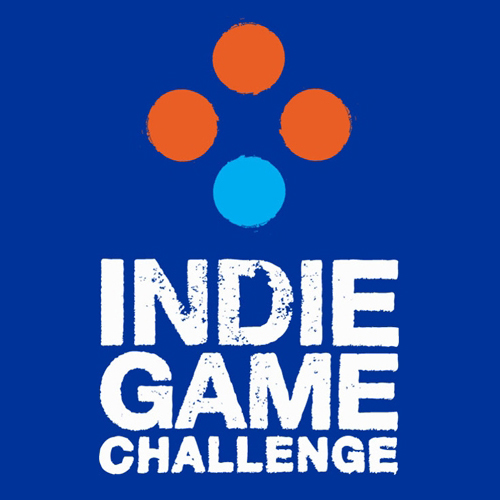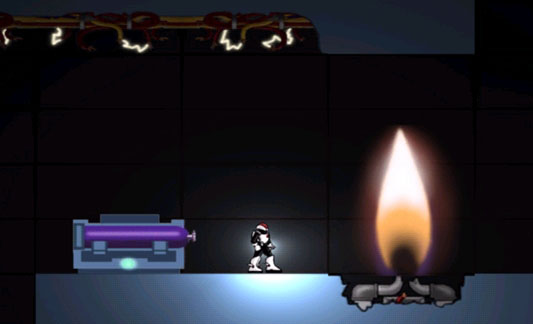"LIMBO" and SMU Team's "INERTIA" claim
top spots in 2011 Indie Game Challenge
The SMU Guildhall team was among the big winners of the international Indie Game Challenge.

LAS VEGAS, NEV. (SMU) – The Indie Game Challenge announced tonight that Playdead’s LIMBO and Team Hermes’ Inertia are the big winners of the second annual Indie Game Challenge. The top teams were named on the closing night of the annual D.I.C.E.™ (Design, Innovate, Communicate, Entertain) Summit at the Red Rock Resort & Casino in Las Vegas.
SMU's TEAM HERMES | |
 | |
 John Bevis |
 Wayland Fong |
 Michelle Hayden |
 Evan Skarin |
 William Swannack |
 Brandon Stephens |
 Christopher McCrimmons |
 Erasmo Simo |
Team Hermes’ members are the first Southern Methodist University (SMU) students to make the finals in the international competition. All eight are part of The Guildhall at SMU Master’s degree program in video game design. The Guildhall at SMU is located on the SMU-in-Plano campus at 5232 Tennyson Parkway in Plano.
A total of 90 individuals selected by the Academy of Interactive Arts & Sciences (AIAS) served as judges for the competition – all professional game designers with groundbreaking titles on their résumés.
The team won $130,000 in cash and prizes for their efforts.
“We’re so excited for Team Hermes,” said Peter Raad, The Guildhall at SMU founder and executive director. “Our graduate program is extremely challenging and our students are very busy on class projects. When we decided to become one of the founding members of the Indie Game Challenge, we realized that our own Master’s degree candidates would have very little chance to create a winning entry.
“The total production time for Inertia was 12 weeks while some of the other professional and non-professional finalists worked on their entries for two years or more,” Raad explained. “This winning game is a tremendous accomplishment that our students essentially did in a six week class project and then six weeks on their own during a break in the summer. We could not be prouder of them.”
Inertia features an innovative mechanic that allows players to suspend gravity and use inertia to bounce off walls, float through space, and move through the game’s environment – a decaying space station on the brink of collapse.
“Since Inertia was developed at SMU, without a doubt the hardest part about making it was finding the time to balance between working on the game as a team and individual assignments from other classes,” said team leader Evan Skarin in an interview for the IGC website. “Our artist and programmer were also required to split time with other projects, so the level designers had to fulfill multiple roles in order to get the job done.”
Hosting the awards ceremony for the second year was industry veteran Adam Sessler, Editor-in-Chief of Game Content for the G4 Network and Host of G4’s “X-Play.” Attendees included top video game publishing executives and developers, representatives of influential gaming media outlets, and the 12 finalist teams. For those who did not attend this year’s event, exclusive IGC online content will be posted on G4tv.com/DICE.
The winners and awards include:
Professional $100,000 Grand Prize and $15,000 EEDAR DesignMetrics® Winner: LIMBO
- LIMBO was created by Playdead, an independent game studio based in Copenhagen, Denmark. LIMBO, a 2D sidescroller puzzle-platform video game released on Xbox Live Arcade, is Playdead’s first production with Arnt Jensen as Game Director.
Non-professional $100,000 Grand Prize and $15,000 EEDAR DesignMetrics® Winner: Inertia
- Inertia was created by Team Hermes, an eight-member group from The Guildhall at SMU. Inertia, recently published on Xbox Live Arcade, is a 2D platform arcade game in which an astronaut tries to escape a space station on the verge of collapse, allowing players to manipulate gravity and travel across the galaxy.
Category winners include:
- Kongregate Award for best browser-based game: Symon
- Technical Achievement ($2,500): Inertia
- Achievement in Art Direction ($2,500): LIMBO
- Achievement in Gameplay ($2,500): Inertia
- Gamer’s Choice Award, selected through online voting ($10,000): Inertia
- Electronic Entertainment and Research DesignMetrics® title research assessments to Inertia and Limbo worth $30,000 for both groups combined
The recipient of the $50,000 Indie Game Challenge SMU scholarship will be announced later this year. SMU students are not eligible for this award.
Entries for the second annual Indie Game Challenge were accepted between May 3 and October 1, 2010. Judging was done by members of AIAS starting December 3, 2010, and 12 finalists -- six professional teams and six non-professional teams -- were announced January 20, 2011. SMU’s role in the contest is to prepare the games for judging. SMU does not have any part in the official judging of the contest, and teams are identified by team names only.
Professional and non-professional game developers interested in entering the 2012 Indie Game Challenge will be able to submit applications via the Indie Game Challenge website from May 1, 2011 through October 3, 2011. Finalists will be named in Winter 2012, and the winners at the 2012 D.I.C.E. Summit. Exact dates will be announced later this year.
For more information on the competition and to learn more about each of the winners, visit: www.IndieGameChallenge.com
About the Indie Game Challenge
The Indie Game Challenge (IGC) is an annual competition for video game developers offering more than $350,000 in prizes for professional and non-professional categories. Founded by the Academy of Interactive Arts & Sciences, GameStop Corp. and The Guildhall at SMU, the IGC was created to foster game development innovation by independent developers. Prizes include cash awards, scholarships, national consumer exposure for the top games and an opportunity for the finalists to obtain professional feedback and seek commercial avenues for their games through face-to-face meetings with representatives from the leading video game publishers. For more information on the IGC visit:
About The Guildhall at SMU
The Guildhall at Southern Methodist University is the premier graduate video game education program in the US. Many of the school’s founders are industry icons, and classes are run by industry veterans. Since 2005, the program has graduated over 385 students and alumni are working at more than 120 video game studios around the world. Our program offers a Master’s degree in Interactive Technology and a graduate Professional Certificate.
For more information, visit The Guildhall website or download the informational brochure (.pdf)
About Team Hermes
SMU's eight-member team, who call themselves "Team Hermes," include
- Evan Skarin - Team Lead, Level Design, and Art
- John Bevis - Level Design and Music
- Wayland Fong - Level Design and Programming
- Michelle Hayden - Art Lead
- William Swannack - Programming Lead
- Brandon Stephens - Executive Producer and Level Designer
- Christopher McCrimmons - Producer and Level Designer
- Erasmo Simo - Level Design and Programming
They graduated in December 2010 from Guildhall, SMU’s nationally recognized, graduate level educational video game development program.
MEDIA CONTACT:
Ron Jenkins
The Guildhall at SMU
972-473-3546
www.guildhall.smu.edu
###